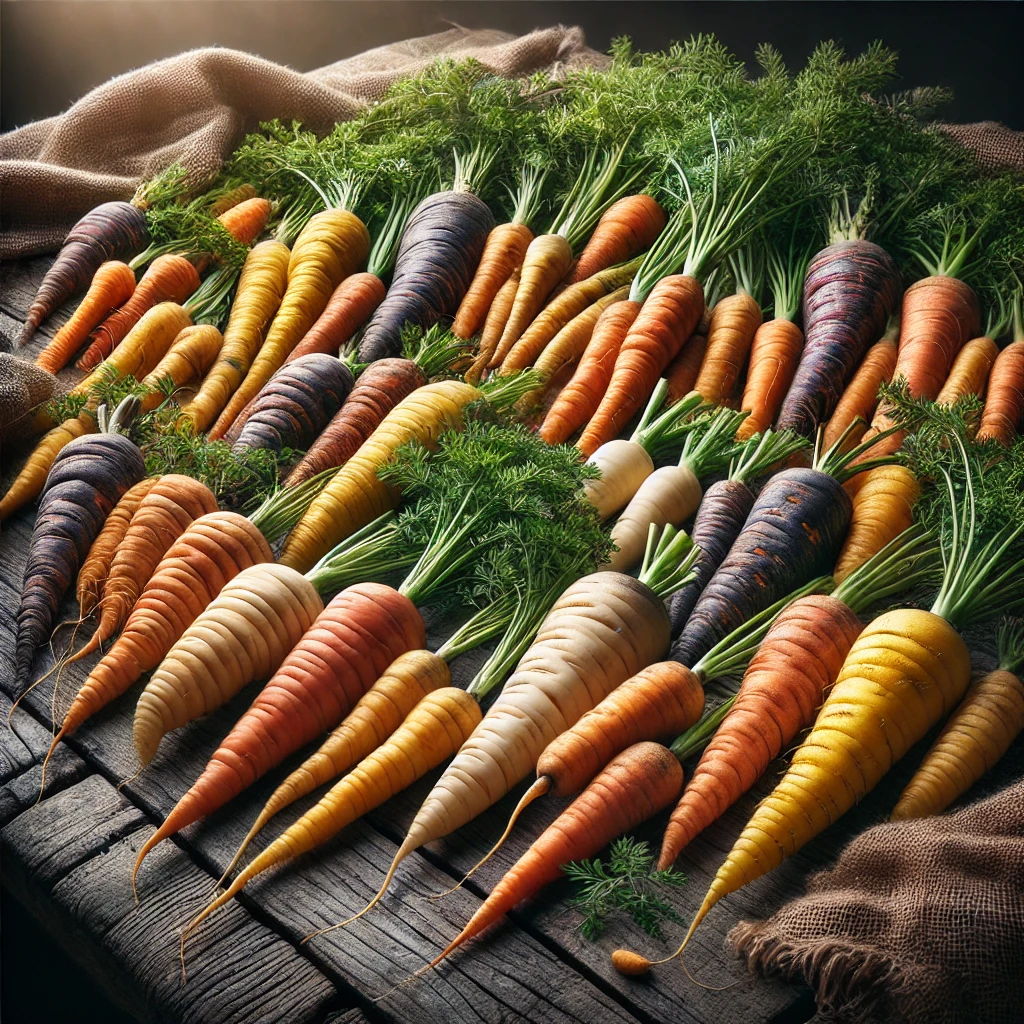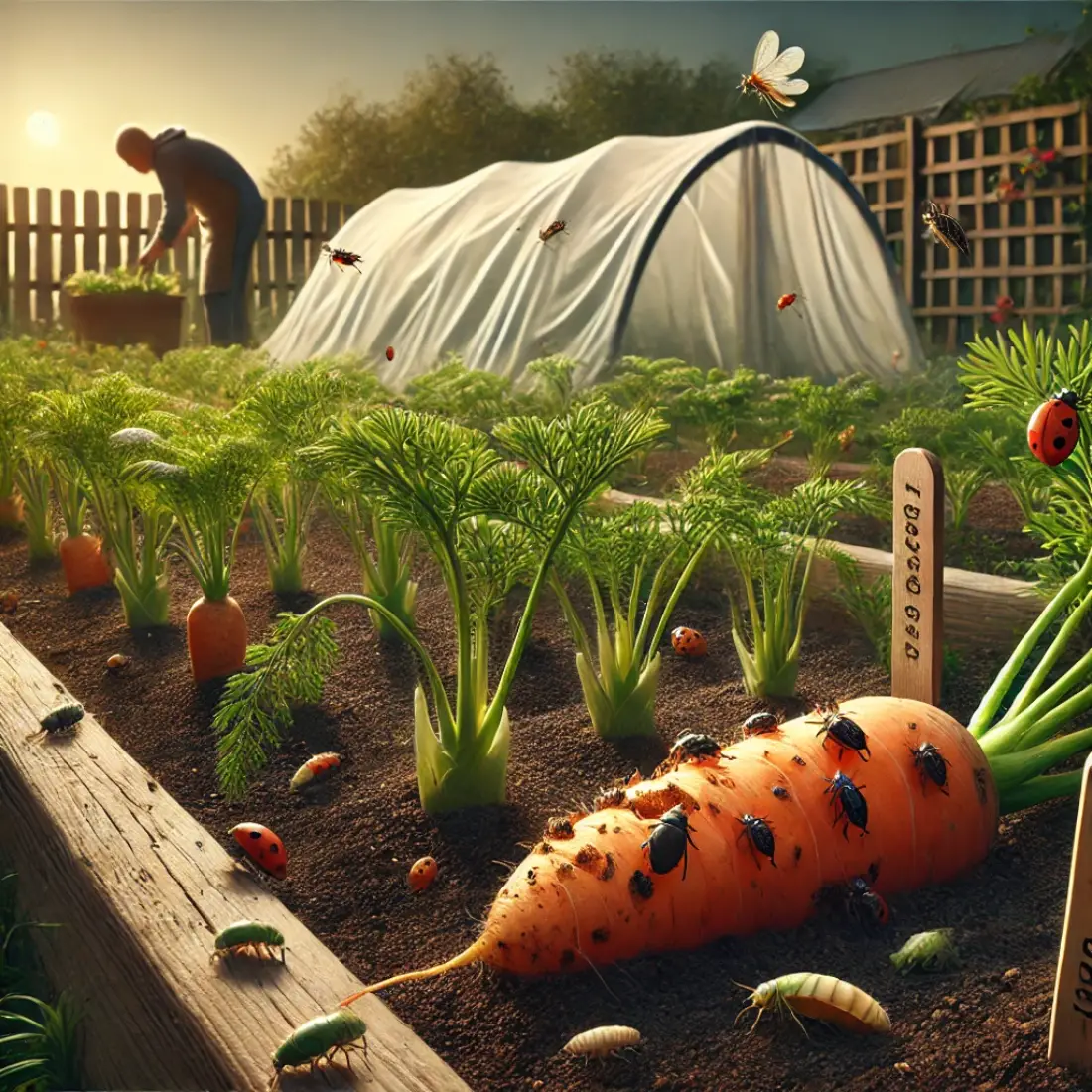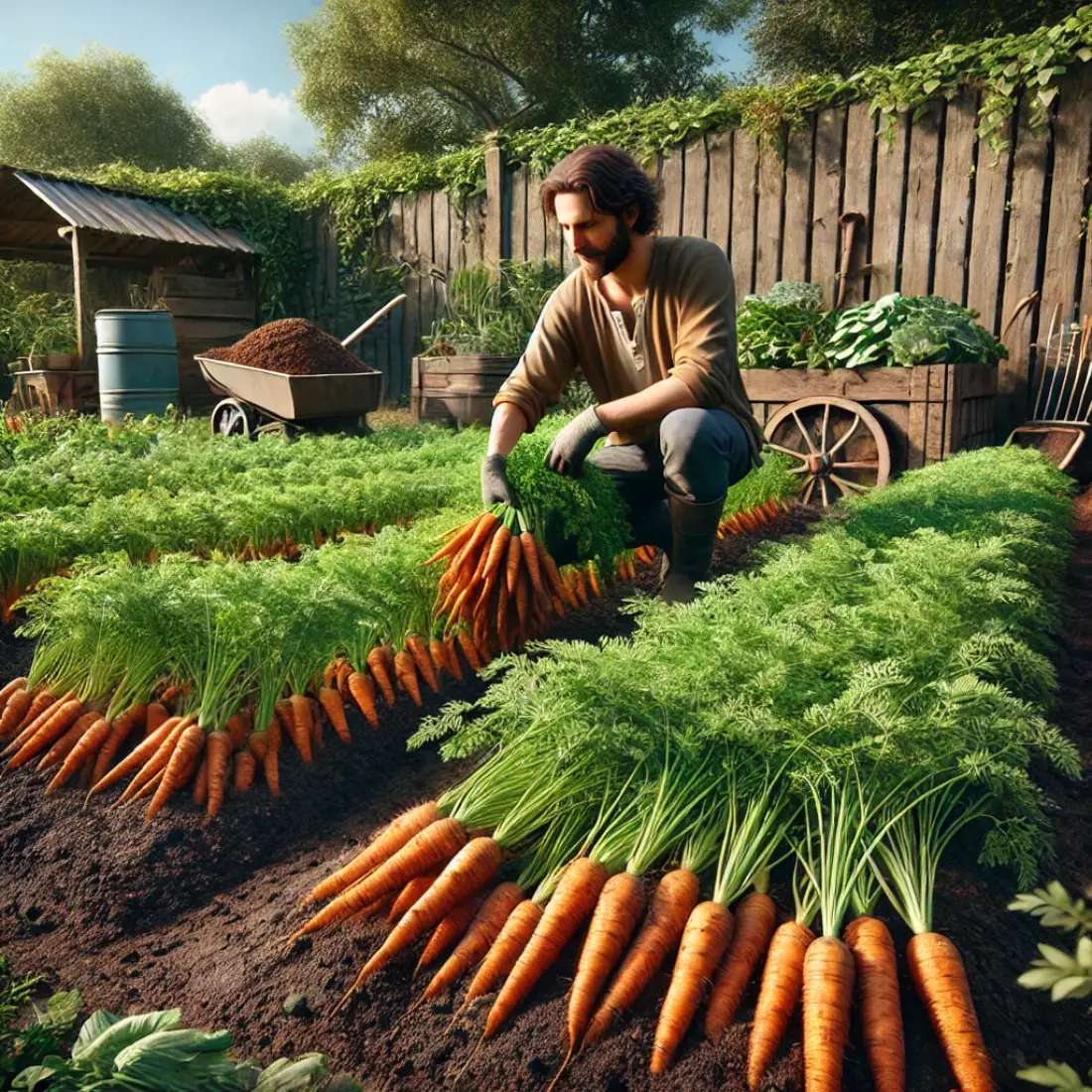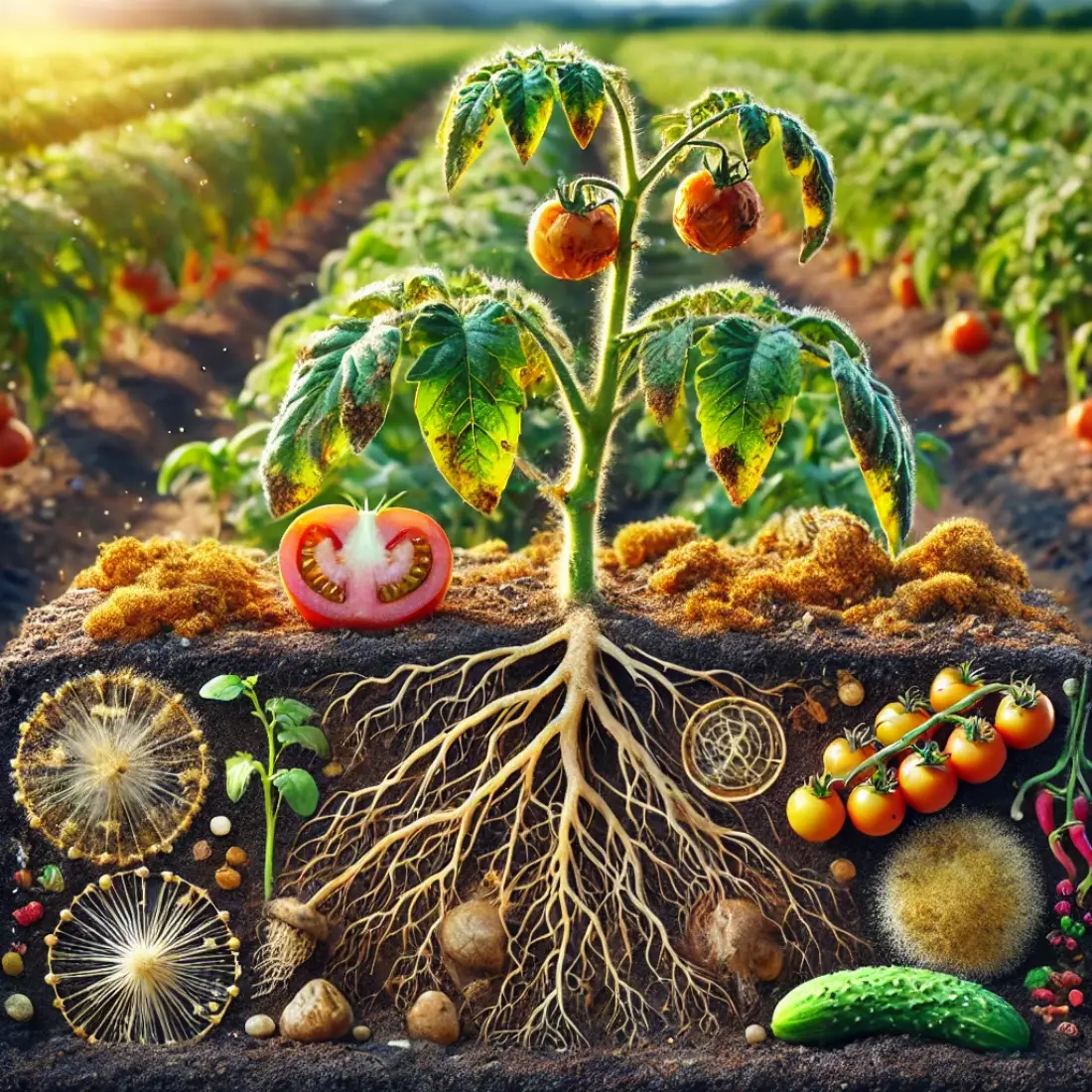Growing carrots organically not only ensures a bountiful harvest of sweet and nutritious vegetables but also promotes a healthier environment and soil. By using organic methods, gardeners can avoid harmful chemicals, improve soil fertility, and cultivate carrots that are rich in flavor and nutrients.
- Healthier Carrots: Organic methods yield carrots free from harmful chemicals.
- Better Soil: Organic practices enhance soil fertility and structure.
- Environmental Benefits: Reduces chemical runoff and pollution.
- Improved Flavor and Nutrition: Organic carrots taste better and are more nutritious.
- Natural Pest Control: Uses natural predators and organic sprays for pest management.
- Weed Management: Mulching and manual weeding keep carrot beds weed-free.
- Water Efficiency: Promotes efficient water use for optimal carrot growth.
- Seasonal Success: Knowing the best times for planting and harvesting ensures a productive season.
Preparing to Grow Carrots
Choosing the Right Carrot Varieties
Selecting the appropriate carrot varieties is essential for successful organic gardening. Consider the following factors:
- Climate Compatibility: Choose varieties suited to your local climate and growing conditions.
- Soil Type: Some carrot types thrive better in specific soil types (sandy, loamy).
- Organic Seeds: Use certified organic seeds to ensure no chemical treatments have been applied.
- Popular Varieties: Nantes, Danvers, and Chantenay are excellent choices for organic gardening due to their resilience and flavor.

Preparing the Soil for Carrots
Proper soil preparation is crucial for healthy carrot growth. Here’s how to get your soil ready:
- Soil Testing: Conduct a soil test to determine pH and nutrient levels. Carrots prefer slightly acidic to neutral pH (6.0-6.8).
- Amending the Soil: Incorporate organic compost to improve soil structure and fertility. Add well-rotted manure or leaf mold for additional nutrients.
- Tilling and Aeration: Till the soil to a depth of at least 12 inches to ensure it’s loose and free of rocks and debris, allowing carrots to grow straight and long.
- Mulching: Apply a layer of organic mulch, such as straw or shredded leaves, to retain moisture and suppress weeds.
Planting Organic Carrots
When to Plant Carrots
Timing is crucial when planting carrots to ensure optimal growth and a bountiful harvest:
- Spring Planting: Sow carrot seeds 2-3 weeks before the last expected frost date. This allows carrots to establish before the heat of summer.
- Fall Planting: For a fall harvest, plant seeds 10-12 weeks before the first expected frost. Carrots grow well in cooler temperatures.
- Succession Planting: Sow seeds every 2-3 weeks to ensure a continuous harvest throughout the growing season.
Sowing Carrot Seeds
Proper sowing techniques can significantly impact the success of your carrot crop:
- Seed Spacing: Plant carrot seeds about 1/4 inch deep, spacing them 2-3 inches apart. This prevents overcrowding and ensures each carrot has enough space to grow.
- Row Spacing: Space rows 12-18 inches apart to allow for easy access and maintenance.
- Seed Thinning: Once seedlings reach 1-2 inches in height, thin them to the desired spacing. This helps reduce competition for nutrients and water.
- Companion Planting: Plant carrots alongside beneficial companions such as onions, leeks, and radishes. These companions help deter pests and improve growth.
- Mulching: After planting, cover the soil with a light layer of mulch to retain moisture and suppress weeds. Organic mulches like straw or compost are ideal.
Caring for Carrots
Watering Techniques
Consistent watering is essential for healthy carrot growth:
- Regular Watering: Water carrots deeply once a week, ensuring the soil remains moist but not waterlogged.
- Drip Irrigation: Use drip irrigation or soaker hoses to provide a steady supply of water directly to the root zone, reducing water waste and preventing foliage diseases.
- Mulching: Apply a layer of organic mulch around the carrot plants to retain moisture, regulate soil temperature, and reduce weed growth.
Organic Fertilization Methods
Feeding your carrots with organic fertilizers promotes strong growth and better yields:
- Compost and Manure: Enrich the soil with well-rotted compost or aged manure before planting. These provide essential nutrients and improve soil structure.
- Liquid Fertilizers: Use organic liquid fertilizers like fish emulsion or seaweed extract every 4-6 weeks during the growing season. These provide a quick nutrient boost and support healthy root development.
- Green Manure: Plant cover crops, such as clover or alfalfa, in the off-season to add organic matter and nutrients to the soil.
Weed Control in Carrot Gardens
Keeping your carrot bed weed-free ensures healthy growth and reduces competition for nutrients:
- Manual Weeding: Regularly hand-weed around carrot plants to prevent weeds from overtaking the garden. Be gentle to avoid disturbing the shallow carrot roots.
- Mulching: Use organic mulch, like straw or grass clippings, to suppress weed growth and retain soil moisture.
- Hoeing: Lightly hoe the soil surface to remove small weeds before they become established. Be careful not to damage the carrot roots.
Managing Pests and Diseases
Common Pests Affecting Carrots
Carrots are vulnerable to several pests, but organic methods can effectively manage these issues:
- Carrot Rust Fly: These pests lay eggs near the base of carrot plants. Larvae then tunnel into the roots, causing damage. Use row covers to prevent adult flies from laying eggs and practice crop rotation to disrupt their life cycle.
- Aphids: Small, sap-sucking insects that can weaken plants. Introduce natural predators like ladybugs and lacewings or use insecticidal soap made from organic ingredients.
- Cutworms: These pests can sever young carrot plants at the base. Handpick cutworms at night and use cardboard collars around seedlings to protect them.

Organic Pest Control Methods
Implement these organic strategies to keep pests at bay:
- Companion Planting: Grow carrots alongside plants that repel pests, such as onions, garlic, and marigolds. These companions help deter harmful insects.
- Neem Oil: Spray neem oil solution on carrot plants to repel pests like aphids and caterpillars. Neem oil is a natural insecticide that is safe for organic gardening.
- Beneficial Insects: Encourage beneficial insects like ladybugs, lacewings, and parasitic wasps by planting flowers such as dill, fennel, and yarrow. These insects prey on common carrot pests.
Organic Disease Management
Diseases can affect carrot crops, but organic practices can minimize their impact:
- Fungal Diseases: Diseases like Alternaria leaf blight and powdery mildew can harm carrot plants. Use disease-resistant varieties and ensure proper spacing for air circulation. Apply a baking soda solution (1 tablespoon baking soda per gallon of water) to affected areas to control mildew.
- Bacterial Diseases: Bacterial leaf blight can be controlled by rotating crops and avoiding overhead watering, which can spread bacteria. Remove and destroy infected plants to prevent the disease from spreading.
- Root Rot: This can be caused by poorly drained soil. Improve soil drainage by adding organic matter and ensuring the planting area is not waterlogged.
Harvesting and Storing Carrots
When and How to Harvest Carrots
Knowing when and how to harvest carrots is crucial for the best quality:
- Timing: Carrots are usually ready to harvest 70-80 days after planting. Look for mature carrots when the tops reach about 1/2 to 3/4 inch in diameter.
- Testing Readiness: Gently pull one or two carrots to check their size. If they are of the desired size, it’s time to harvest.
- Harvesting Technique: Loosen the soil around the carrots with a garden fork before gently pulling them up by the tops to avoid breaking the roots. Harvest in the morning when the soil is cool and moist for easier removal.
Storing Carrots
Proper storage methods can keep your carrots fresh and crisp for months:
- Immediate Post-Harvest Care: Remove the green tops from the carrots immediately after harvest, as they draw moisture and nutrients from the roots.
- Storage Conditions: Store carrots in a cool, dark, and humid place. Ideal storage temperatures are between 32-40°F with high humidity (90-95%).
- Refrigerator Storage: Place carrots in perforated plastic bags or wrap them in damp paper towels and store them in the crisper drawer of your refrigerator.
- Cellar Storage: If you have a root cellar, store carrots in layers of damp sand or sawdust. This method maintains moisture and prevents the carrots from drying out.
- Long-Term Preservation: For long-term storage, consider canning, freezing, or pickling your carrots. Blanching carrots before freezing helps preserve their flavor and texture.
FAQs About Growing Organic Carrots
How long do carrots take to grow organically?
Carrots typically take 70-80 days to mature from the time of planting, depending on the variety and growing conditions.
Can I grow carrots in containers organically?
Yes, carrots can be grown in containers. Use deep pots with loose, well-draining organic soil, and ensure they receive adequate sunlight and water.
What are the best companion plants for carrots?
Good companion plants for carrots include onions, leeks, radishes, and marigolds, as they help deter pests and improve growth.
How do I prevent my carrots from becoming misshapen?
Ensure the soil is loose and free of rocks or debris, and maintain consistent moisture levels to prevent misshapen carrots.
Are there any organic fertilizers specifically for carrots?
Organic options like compost, aged manure, fish emulsion, and seaweed extract are excellent for fertilizing carrots.
How do I deal with pests on my organic carrots?
Use row covers to prevent pests like carrot rust fly, introduce beneficial insects, and apply organic sprays like neem oil to manage pests.
What should I do if my carrots are not germinating?
Ensure the soil is consistently moist during the germination period, and consider using a seedling heat mat to maintain optimal soil temperature.
Can I grow carrots organically in all climates?
Carrots can be grown in most climates, but they prefer cooler temperatures. Planting times should be adjusted based on local climate conditions.
How often should I water my organic carrots?
Water deeply once a week, ensuring the soil remains moist but not waterlogged. Mulching can help retain moisture and reduce the need for frequent watering.
How can I store my harvested organic carrots to keep them fresh?
Remove the green tops, store carrots in a cool, dark, and humid place, and consider using damp sand or sawdust in a root cellar for long-term storage.









